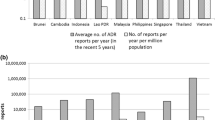Abstract
Background and Objective
New pharmacovigilance legislation in the European Union has underlined the importance of signal management, giving the European Medicines Agency’s newly established Pharmacovigilance Risk Assessment Committee (PRAC) the mandate to oversee all aspects of the use of medicinal products including detection, assessment, minimization, and communication relating to the risk of adverse reactions. In this study, we describe the signals as brought to the PRAC during the first 18 months of its operation and the ensuing regulatory actions.
Methods
Data were collected from publicly available sources, for the period July 2012–December 2013, classified according to predefined rules, and described using the appropriate descriptive statistics. Suspected adverse drug reactions were categorized into the Medical Dictionary for Regulatory Affairs and drug names were mapped to the Anatomical Therapeutic Chemical codes.
Results
During the study period, 125 signals concerning 96 medicinal products were discussed by the PRAC. The majority of signals were triggered by spontaneous reports (62 %) and the median drug age (since marketing authorization) for drugs that prompted a signal was 12 years, significantly less compared with drugs that had no signal within the same period (20 years). The mean time until a decision was reached by the PRAC was 75 days (median 30 days, range 0–273) with 43 % of all decisions taken during the first meeting. The decisions to start a referral and to send a direct healthcare professional communication took the least amount of time [54 days (median 27 days, range 0–186) and 51 days (median 0 days, range 0–153)].
Conclusions
The importance of spontaneous reporting in signal detection and monitoring of safety issues throughout the entire life cycle of a medicinal product is confirmed in this study. The amount of time a drug has been on the market is correlated with the number of signals detected. The PRAC decision-making process seems efficient particularly with respect to serious concerns; its role in improving signal prioritization and real-time signal management will be further clarified in its subsequent years of operation.



Similar content being viewed by others
References
Amery WK, ISPE. Why there is a need for pharmacovigilance. Pharmacoepidemiol Drug Saf. 1999;8:61–4.
Vandenbroucke JP. Observational research, randomised trials, and two views of medical science. PLoS Med. 2008;5:e67.
Stricker BHC, Psaty BM. Detection, verification, and quantification of adverse drug reactions. BMJ. 2004;329:44–7.
CIOMS Working Group. Practical aspects of signal detection in pharmacovigilance. Geneva; 2010.
EMA. Guideline on good pharmacovigilance practices, Module IX: signal management. 2012.
Commission Implementing Regulation (EU) No 520/2012. 2012.
Directive 2010/84/EU of the European Parliament and of the Council (Internet). (cited 2014 Apr 5). http://eur-lex.europa.eu/LexUriServ/LexUriServ.do?uri=OJ:L:2010:348:0074:0099:EN:PDF.
Countdown to July 2012: the establishment and functioning of the PRAC, EMA/315258/2012 (Internet). (cited 2014 Apr 15). http://www.ema.europa.eu/docs/en_GB/document_library/Other/2012/07/WC500129301.pdf.
Arlett P, Portier G, de Lisa R, Blake K, Wathion N, Dogne JM, Spooner A, Raine J, Rasi G. Proactively managing the risk of marketed drugs: experience with the EMA Pharmacovigilance Risk Assessment Committee. Nat Rev Drug Discov. 2014;13:395–7.
PRAC meeting minutes (Internet). (cited 2014 Apr 15). http://www.ema.europa.eu/ema/index.jsp?curl=pages/about_us/document_listing/document_listing_000353.jsp&mid=WC0b01ac05805a21cf.
PRAC recommendations on safety signals (Internet). (cited 2014 Apr 15). http://www.ema.europa.eu/ema/index.jsp?curl=pages/regulation/document_listing/document_listing_000375.jsp.
MedDRA. Introductory guide MedDRA version 15.1, MSSO-DI-6003-15.1.0. 2012.
Ishiguro C, Hall M, Neyarapally GA, Dal Pan G. Post-market drug safety evidence sources: an analysis of FDA drug safety communications. Pharmacoepidemiol Drug Saf. 2012;21:1134–6.
Pontes H, Clément M, Rollason V. Safety signal detection: the relevance of literature review. Drug Saf. 2014;37:471–9.
Moore TJ, Singh S, Furberg CD. The FDA and new safety warnings. Arch Intern Med. 2012;172:78–80.
Lester J, Neyarapally GA, Lipowski E, Graham CF, Hall M, Dal Pan G. Evaluation of FDA safety-related drug label changes in 2010. Pharmacoepidemiol Drug Saf. 2013;22:302–5.
Giezen TJ, Mantel-Teeuwisse AK, Straus SMJM, Schellekens H, Leufkens HGM, Egberts ACG. Safety-related regulatory actions for biologicals approved in the United States and the European Union. JAMA. 2008;300:1887–96.
Ciszkowski C, Madadi P, Phillips MS, Lauwers AE, Koren G. Codeine, ultrarapid-metabolism genotype, and postoperative death. N Engl J Med. 2009;361:827–8.
Mol PGM, Arnardottir AH, Motola D, Vrijlandt PJ, Duijnhoven RG, Haaijer-Ruskamp FM, et al. Post-approval safety issues with innovative drugs: a European cohort study. Drug Saf Int J Med Toxicol Drug Exp. 2013;36:1105–15.
Powers A, Cook G. Potential safety signals and their significance. Arch Intern Med. 2012;172:72–3.
Hochberg AM, Reisinger SJ, Pearson RK, O’Hara DJ, Hall K. Using data mining to predict safety actions from FDA adverse event reporting system data. Drug Inf J. 2007;41:633–43.
Edwards IR. Good pharmacovigilance practice and the curate’s egg. Drug Saf Int J Med Toxicol Drug Exp. 2012;35:429–35.
Acknowledgments
No sources of funding were used to conduct this study or prepare this manuscript. Georgy Genov is the head of the Signal Management Section at the European Medicines Agency. Miriam Sturkenboom is heading a research group that conducts unconditional research on the safety and effects of drugs for several pharmaceutical companies (AstraZeneca, Pfizer, Eli Lilly), none of which is related to this current research. Alexandra Pacurariu, Preciosa Coloma, Anja van Haren, and Sabine Straus have no conflicts of interest that are directly relevant to the content of this study. The views expressed in this article are the personal views of the author(s) and may not be understood or quoted as being made on behalf of or reflecting the position of the Dutch Medicines Agency or the European Medicines Agency or one of its committees or working parties.
Author information
Authors and Affiliations
Corresponding author
Electronic supplementary material
Below is the link to the electronic supplementary material.
Rights and permissions
About this article
Cite this article
Pacurariu, A.C., Coloma, P.M., van Haren, A. et al. A Description of Signals During the First 18 Months of the EMA Pharmacovigilance Risk Assessment Committee. Drug Saf 37, 1059–1066 (2014). https://doi.org/10.1007/s40264-014-0240-1
Published:
Issue Date:
DOI: https://doi.org/10.1007/s40264-014-0240-1




